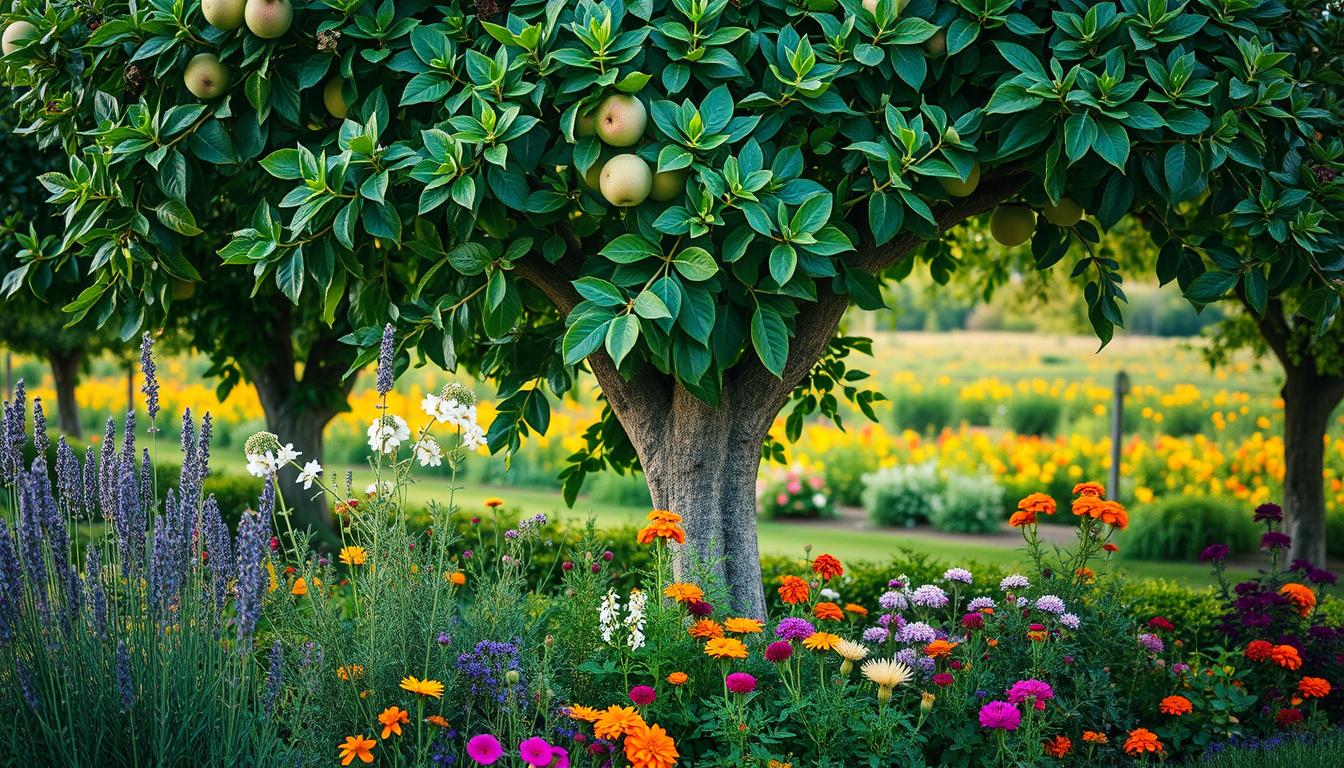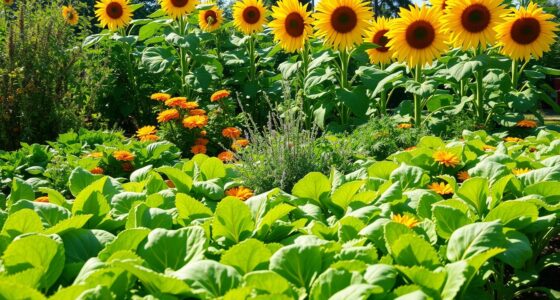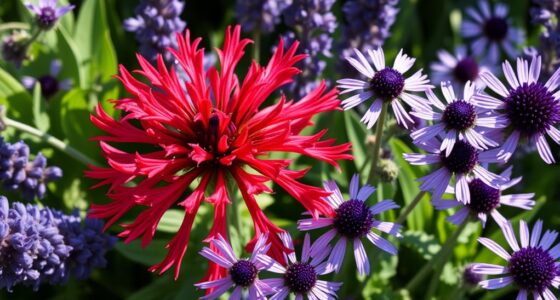Have you ever wandered through an orchard, marvelling at the vibrant ecosystem teeming with life? The gentle rustle of leaves, the sweet smell of fruit, and the hum of bees all working together create a symphony of nature. In your own backyard, you can experience this harmony too! By exploring apple tree companion plants, you can cultivate a thriving environment that enhances not only the health of your apple trees but also your gardening experience. Incorporating the best companion plants for apple trees can transform your space, making it a haven for biodiversity and a celebration of nature’s interconnections. Join us as we delve into the world of apple tree guild planting, where every plant plays a role in the well-being of your beloved apple trees.
Key Takeaways
- Apple tree companion plants boost the health and productivity of your trees.
- Strategic planting enhances soil quality and ecological balance.
- Companion planting creates vibrant biodiversity in your garden.
- Choose the best companion plants for apple trees to increase yields.
- Establishing a guild around your apple trees fosters a self-sustaining environment.
- Experience the joy of nurturing and harvesting from a thriving orchard.
Understanding Companion Planting
Companion planting is a gardening technique that brings together various plants to support one another’s growth. This method thrives on the idea that certain plants have a natural synergy, leading to enhanced health and productivity. Utilizing this strategy with apple trees can transform your orchard into a thriving ecosystem filled with vitality and balanced interactions among your apple tree beneficial plant partners.
What is Companion Planting?
In essence, companion planting involves strategically placing specific plants alongside others to achieve various benefits. These benefits can include improved growth rates, enhanced pest control, and increased efficiency in nutrient absorption. This holistic approach not only promotes healthier apple trees but also contributes to an enriched garden environment.
Benefits of Companion Planting for Apple Trees
Utilizing an apple tree companion planting guide can certainly improve your apple tree’s overall health. By incorporating carefully chosen companion plants, you can attract beneficial insects, which are crucial in pollination and pest management. Some plants can even deter harmful pests that can threaten your apple trees. In addition, these complementary plants contribute to the soil’s nutrient content, which directly enhances the flavor and quality of your apples. This ensures a more sustainable gardening practice while boosting your apple harvest.

The Best Companion Plants for Apple Trees
Choosing the right companion plants can significantly enhance your apple tree’s growth and health. By incorporating a mix of herbs, flowers, and vegetables, you can create a thriving apple tree polyculture that benefits the entire ecosystem. This approach not only improves soil quality but also attracts vital pollinators and natural pest deterrents.
Herbs That Thrive with Apple Trees
Various herbs work exceptionally well alongside apple trees. Plants like chamomile, coriander, basil, and chives contribute to apple tree intercropping efforts. These herbs not only deter pests but also enhance soil health, creating a more vibrant growing environment for your apple trees.
Flowers That Attract Pollinators
Flowers play a crucial role in attracting pollinators, which are essential for fruitful apple trees. Marigolds, yarrow, and lavender are ideal options as companion plants. These flowers lure beneficial insects, ensuring proper fertilization for your apple tree’s blossoms. A diverse selection of flowers promotes a healthier ecosystem, leading to more abundant harvests.
Vegetables to Plant Near Apple Trees
Integrating vegetables into your apple tree polyculture can enhance the intercropping experience. Options such as rhubarb and beans can contribute positively to this combination. When planting vegetables, consider their spacing and compatibility with apple trees. By selecting the right vegetables, you can create a harmonious environment that benefits everyone involved.
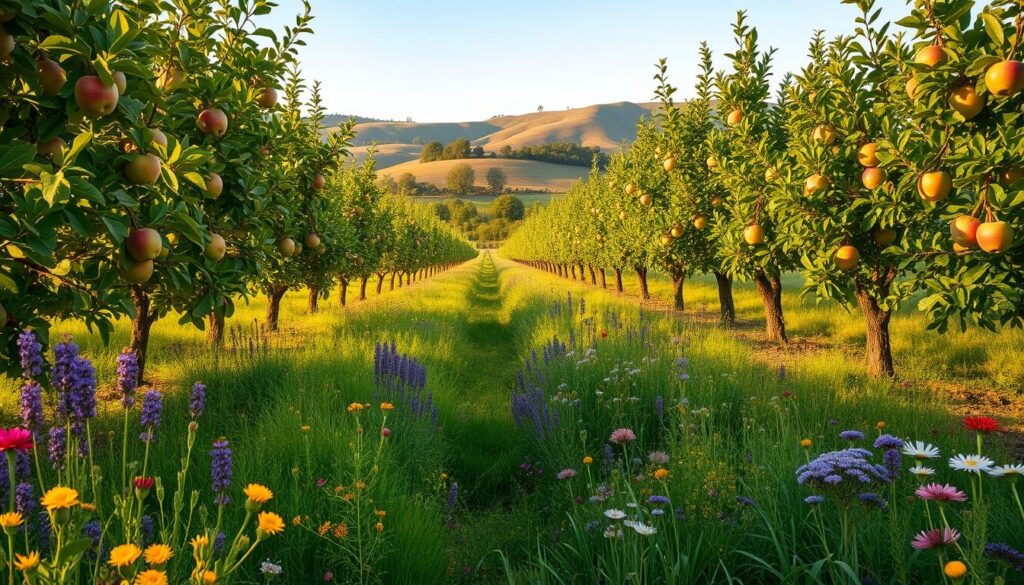
Planting Herbs Around Your Apple Tree
Incorporating herbs into your apple tree guild planting can lead to diverse benefits, enhancing the overall health of your orchard. Herbs not only contribute flavor and nutrition but also work against pests and diseases that may harm apple trees. Creating an ecosystem that promotes harmony through apple tree biodiversity planting will yield fruitful rewards.
Benefits of Herbs as Companions
Herbs provide numerous advantages when planted near apple trees. They can deter pests, improve soil quality, and attract beneficial insects. For example, when basil and chives grow alongside apple trees, they act as natural repellents to harmful insects while enriching the soil with nutrients. Moreover, various herbs enhance the flavor of apples, making them a delightful choice for companion planting.
Recommended Herbs for Apple Trees
Here are some of the most beneficial herbs to consider when planning your apple tree guild planting:
| Herb | Benefits |
|---|---|
| Basil | Repels harmful insects and enhances apple flavor. |
| Chives | Combats diseases like apple scab and attracts pollinators. |
| Fennel | Improves soil fertility and attracts beneficial insects. |
| Mint | Helps deter pests while refreshing the orchard’s aroma. |
| Yarrow | Enhances overall biodiversity and improves soil health. |
By selecting these herbs, you create an environment that enriches your apple trees, fostering a productive and sustainable orchard. Embracing the benefits of herbs in your apple tree biodiversity planting can be a rewarding endeavor for both the trees and you.

Selecting Flowering Companions
Choosing the right flowering companions plays a crucial role in the success of your apple tree orchard. The presence of flowers not only enhances the beauty of the garden but also significantly impacts pollination and pest management. By incorporating flowering plants in your apple tree mixed planting strategy, you can create a thriving ecosystem that promotes healthy growth and abundant fruit production.
Why Pollinator Flowers Matter
Pollinator flowers invite bees, butterflies, and other beneficial insects to your orchard. These visitors ensure that your apple trees receive the necessary pollination for fruit development. Without these companions, fruit yields may diminish. Moreover, strategically placed flowering plants can repel harmful pests, providing an added layer of protection for your apple tree companion plants.
Top Flowers to Pair with Apple Trees
- Daffodils: Their vibrant colors attract pollinators while deterring certain pests.
- Marigolds: Known for protecting against nematodes, they also draw in useful insects.
- Bee Balm: This perennial not only attracts bees but also serves as a beautiful border around your apple trees.
- Chives: Lovely purple flowers attract pollinators and help repel aphids.
- Lavender: With its fragrant blooms, this plant draws in bees and can improve the aroma of your orchard.
Incorporating these flowering companions into your apple tree mixed planting will foster a more balanced ecosystem. By promoting pollination and deterring pests, your garden will flourish, creating a visually captivating and productive environment.

Adding Vegetables to Your Apple Orchard
Incorporating vegetables into your apple orchard can transform the gardening experience. These vegetables serve as effective apple tree companion plants, enhancing biodiversity while providing numerous benefits. By carefully selecting which vegetables to grow alongside your apple trees, you create an environment that promotes healthier growth and gardening success.
Companion Vegetables for Apple Trees
Several types of vegetables make excellent companions for apple trees. Rhubarb thrives in similar conditions and can deter pests. Beans, known for their nitrogen-fixing ability, enrich the soil, providing essential nutrients for both apple trees and nearby vegetables. Other viable options include:
- Carrots
- Garlic
- Onions
- Beets
Tips for Planting Vegetables Under Trees
When planting vegetables among apple trees, consider the unique growing conditions of each plant. Ensure that vegetables do not overshadow the apple trees by positioning them where they receive adequate light. Monitor moisture levels for both crops, avoiding excessive competition for water. Following these guidelines will help maximize yields and keep your apple tree companion plants thriving. Planting in rows can create a harmonious balance, enhancing both growth patterns and aesthetics.
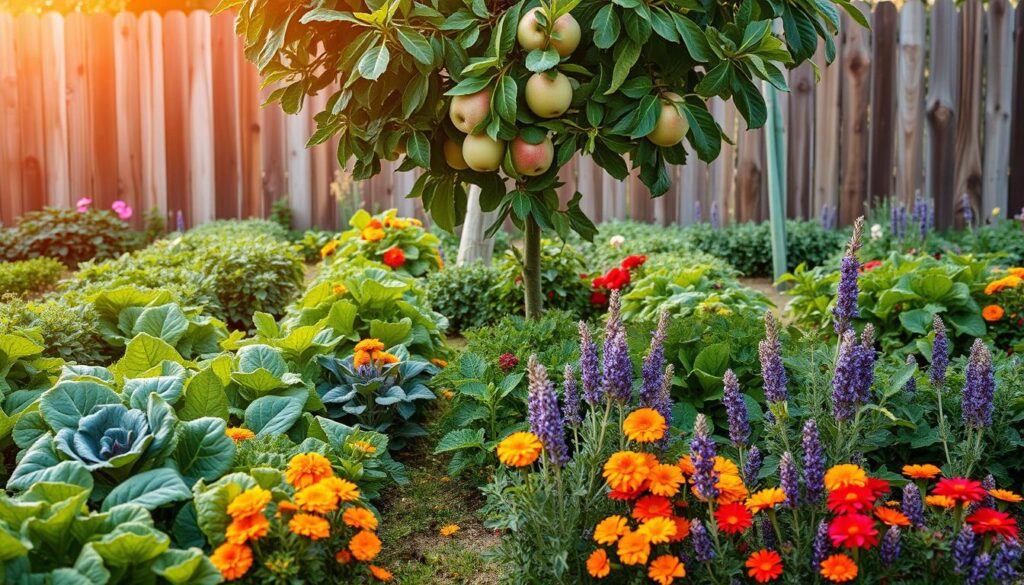
Essential Nutrient Boosters
In the realm of gardening, the concept of apple tree biodiversity planting and apple tree intercropping plays a crucial role in maintaining healthy soil ecosystems. Companion plants can significantly improve soil health, offering essential nutrients while enhancing the growth of your apple trees and their neighboring plants.
How Companion Plants Improve Soil Health
Companion plants, such as legumes, contribute to soil enrichment by fixing nitrogen and improving soil structure. These plants stimulate microbial activity, helping decompose organic matter and releasing nutrients that benefit apple trees. Deep-rooted varieties, like dandelions, can access minerals buried deeper in the soil. As these nutrients are returned to the surface through decomposition, your orchard’s overall fertility increases.
Best Nutrients for Apple Trees and Their Companions
Several key nutrients support the optimal growth of apple trees along with their companions:
| Nutrient | Role | Sources |
|---|---|---|
| Nitrogen | Promotes leaf growth and overall health | Clover, Comfrey |
| Phosphorus | Enhances root development and flowering | Rock phosphate, Bone meal |
| Potassium | Improves disease resistance and fruit quality | Wood ash, Kelp meal |
| Calcium | Strengthens cell walls and supports growth | Gypsum, Lime |
| Magnesium | Essential for photosynthesis | Epsom salt, Dolomitic lime |
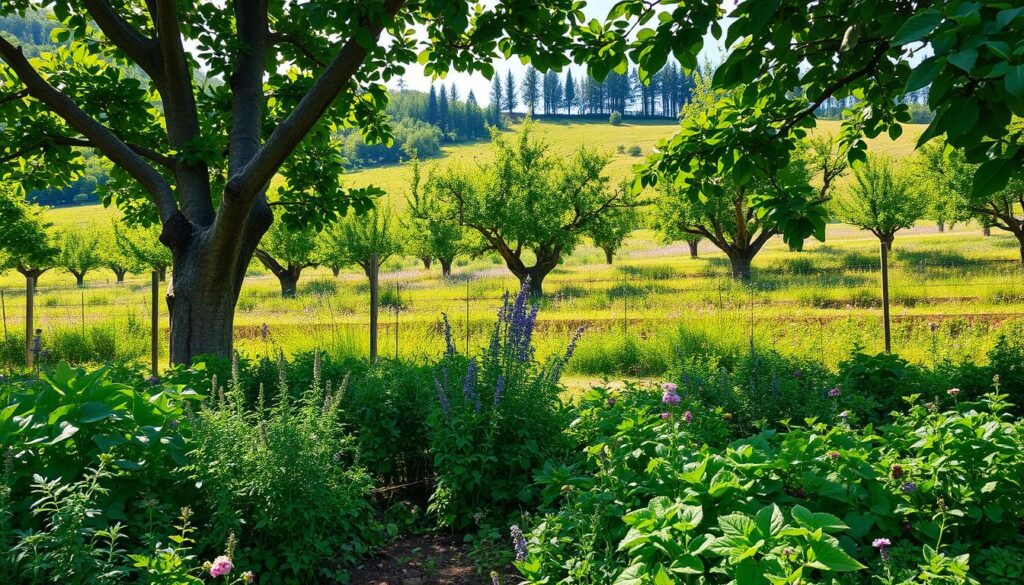
Feeding your soil with these nutrients through companion planting not only boosts the health of your apple trees but also embraces the principles of sustainable gardening. By fostering apple tree intercropping techniques, you create a thriving ecosystem that benefits all plants involved.
Timing Your Planting
Timing plays a vital role in the success of your apple tree companion planting guide. Knowing when to introduce companion plants can enhance your apple tree’s health and productivity. Seasonal changes bring unique benefits and challenges, so aligning your planting schedule with the appropriate time of year is crucial.
When to Plant Companion Plants
You should plant herbs around your apple trees in the spring, as they thrive in warmer temperatures and have a shorter growing season. Summer is ideal for vegetables, which love the sun and can grow alongside your trees during their peak productivity. As fall approaches, consider planting perennials that can provide benefits in the coming seasons.
Seasonal Considerations for Growth
Understanding your local climate and soil conditions will allow you to maximize the benefits outlined in the apple tree companion planting guide. It’s important to monitor temperature and moisture levels to ensure proper growth. For instance, during those hot summer months, both your apple trees and their companions may require additional water. Planting during optimal seasons aligns the growth of your apple trees and companions, building a robust ecosystem in your orchard.
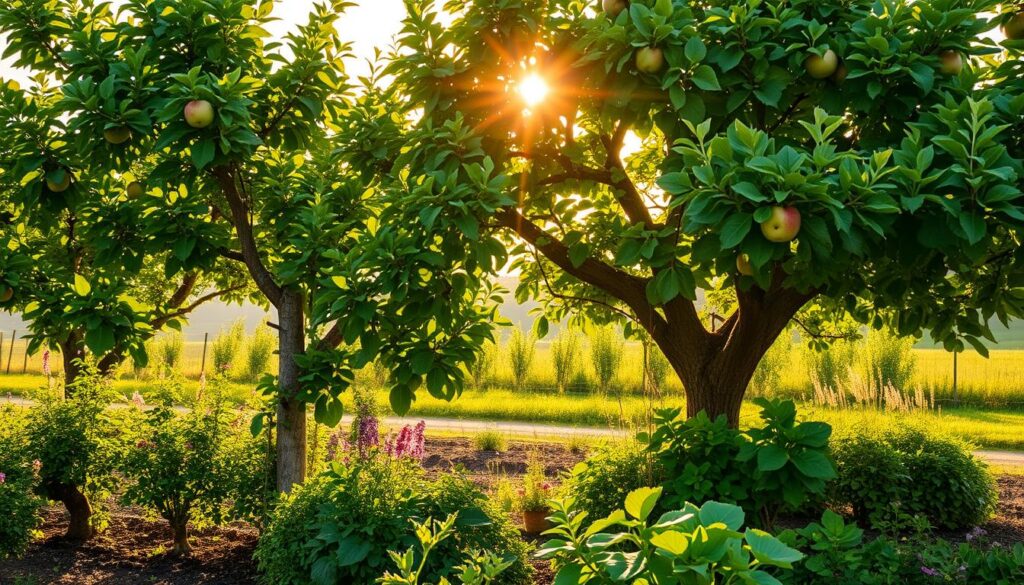
| Companion Plant | Ideal Planting Season | Benefits |
|---|---|---|
| Herbs (e.g., Basil, Mint) | Spring | Enhances soil quality and attracts beneficial insects |
| Vegetables (e.g., Carrots, Radishes) | Summer | Can utilize space under trees while growing |
| Perennials (e.g., Lavender) | Fall | Provides long-term benefits and ground cover |
Managing Pests Naturally with Companions
Creating a naturally pest-resistant environment is one of the top benefits of incorporating apple tree companion plants in your garden. By selecting the right companions, you can deter harmful pests that commonly threaten apple trees, resulting in a healthier and more productive orchard. This pest management strategy focuses on using plants to repel insects, reducing the reliance on chemical solutions.
Natural Pest Control Through Companion Plants
Many apple tree companion plants excel in natural pest management. They emit scents or produce compounds that deter insects. For instance, planting marigolds near your apple trees can keep away nematodes and certain beetles. Mint and lavender are excellent choices as well; their fragrances repel aphids and other pests from your trees, contributing to an organic approach to pest control.
Companion Plants That Deter Common Pests
Here is a list of effective companion plants to incorporate in your apple orchard for a natural defense against pests:
- Marigolds: Deter nematodes and beetles
- Mint: Repels aphids and spider mites
- Lavender: Keeps pests like moths and aphids at bay
- Thyme: Attracts beneficial insects while repelling unwanted pests
- Garlic: Natural insect repellent; strong aroma deters various pests
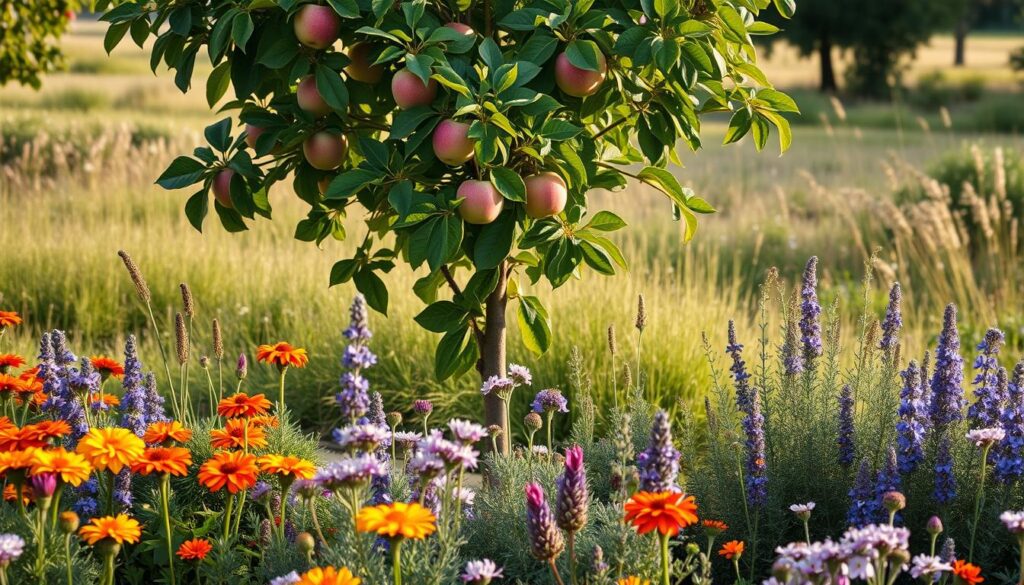
Creating a Balanced Ecosystem
Building a balanced ecosystem in your orchard is vital for achieving long-term sustainability. Biodiversity plays a significant role in this process, enhancing not just the health of your apple trees but also the overall resilience of your garden. Engaging in apple tree guild planting allows various plant species to interact beneficially, paving the way for a thriving community of insects that aid in pollination and pest management.
The Importance of Biodiversity in Your Orchard
Encouraging a diverse range of plants creates a natural balance that can safeguard your apple trees from pests. Diverse plant life attracts beneficial insects that prey on harmful pests, thus reducing the need for chemical interventions. Furthermore, different plants can enhance nutrient uptake and improve soil structure, ensuring that your apple trees receive the necessary nutrients for robust growth.
How to Encourage Beneficial Insects
To foster an environment where beneficial insects thrive, consider incorporating the following strategies:
- Include flowering plants such as yarrow and clover, which attract pollinators and predatory insects.
- Avoid monoculture practices; plant a variety of species together in your apple tree guild planting.
- Utilize native plants, as they are more likely to attract local beneficial insect populations.
- Provide habitat features like insect hotels or undisturbed ground areas where insects can nest.
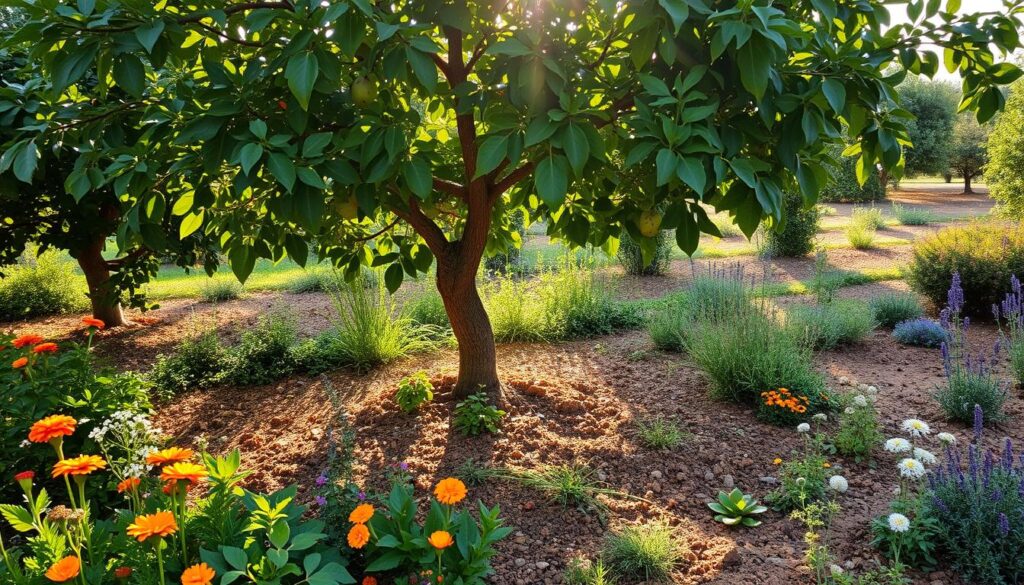
Designing Your Companion Plant Arrangement
Creating an effective layout for apple tree mixed planting is vital for ensuring that all plants thrive together. Thoughtful design allows you to maximize light, space, and resources, leading to a healthier ecosystem in your garden. Consider both vertical and horizontal arrangements to make the most of your available area. By grouping compatible plants that require similar sun exposure and growth habits, you can encourage stronger growth for both your apple trees and their companions.
Layout Ideas for Companion Planting
When planning your companion planting, think about the following ideas:
- Place taller plants on the north side of apple trees to prevent shading lower plants.
- Mix flowering companions with vegetables to attract pollinators effectively.
- Group herbs like basil and oregano, which not only complement apple trees but also deter pests.
Tips for Spacing and Sun Requirements
Proper spacing is crucial in apple tree mixed planting. Here are some tips to consider:
- Give each plant enough room to grow without overcrowding.
- Ensure sun-loving plants are placed where they will receive maximum sunlight.
- Monitor the height of companion plants, adjusting their placement based on mature growth.
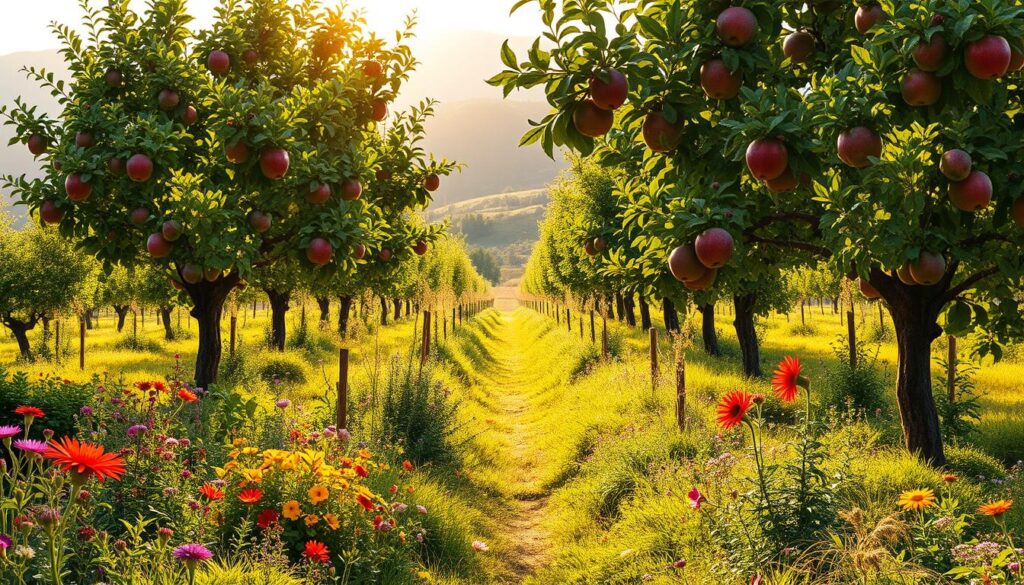
Maintaining Your Orchard
Proper maintenance is crucial for the success of your orchard. By paying attention to the care of both apple trees and their companion plants, you can create an environment that fosters growth and health. Utilizing an effective watering strategy can ensure your plants thrive while following the apple tree companion planting guide.
Care Tips for Apple Trees and Their Companions
Regular monitoring of soil moisture plays a vital role in maintaining your orchard. Here are a few care tips to keep in mind:
- Assess soil moisture levels frequently to avoid over-watering or under-watering.
- Apply mulch around the base of your apple trees and companion plants to retain moisture.
- Regularly prune your apple trees to promote airflow and prevent disease.
- Consider the specific needs of both apple trees and companion plants when planning your care routine.
Watering Strategies for Companion Plant Success
A tailored watering strategy can enhance growth and maintain a healthy relationship between apple trees and companion plants. Consider these strategies:
| Plant Type | Watering Frequency | Water Requirement |
|---|---|---|
| Apple Trees | Once a week | Deep watering (1-2 inches) |
| Herbs | 2-3 times a week | Moderate moisture |
| Vegetables | Every 3-5 days | Consistent moisture |
| Flowers | Once a week | Light to moderate moisture |
Following these care tips along with the apple tree companion planting guide can help ensure that your orchard continuously flourishes and remains productive throughout the seasons.

Harvesting Benefits from Companions
Understanding when to harvest your apple tree and its beneficial plant partners can make a significant difference in your overall yield. Proper timing ensures that you enjoy the best flavors and quality from both apples and companion plants. Early-season crops should be taken before apple trees bloom to avoid overcrowding, creating a harmonious environment for growth.
When to Harvest Companions and Apples
The timing of your harvest plays a crucial role in maximizing the benefits from your garden. For herbs and vegetables, early harvesting can enhance the flavor and stimulate further growth. Apples typically reach full maturity in late summer to fall, depending on the variety. Pay attention to signs such as color and firmness to determine the right moment.
Tips for Maximizing Your Harvest
To make the most out of your apple tree and its beneficial plant partners, consider the following:
- Utilize staggered planting to ensure continuous production throughout the growing season.
- Regularly prune your companion herbs to promote new growth and improve fruit quality.
- Harvest during cooler parts of the day to maintain freshness and prevent damage.
- Implement crop rotation to enhance soil health and increase productivity in subsequent seasons.

Troubleshooting Companion Planting Issues
When diving into the world of companion planting, you may face various challenges that can affect the growth and productivity of your apple trees. This part of the apple tree companion planting guide highlights some common problems associated with companion plants and offers effective solutions to enhance your garden’s success.
Common Problems with Companion Plants
While companion planting can lead to numerous benefits, it can sometimes result in unexpected issues, such as:
- Nutrient competition among plants, which may stunt growth.
- Disease transmission between species, causing widespread plant health issues.
- Pest attraction, where plants lure unwanted insects that impact apple trees.
Solutions for Successful Growth
Mitigating these challenges requires a proactive approach. Here are some strategies informed by the apple tree companion planting guide:
- Regularly evaluate the health of both apple trees and companion plants, allowing you to identify issues early.
- Ensure adequate spacing between plants to reduce competition for nutrients and sunlight.
- Implement natural remedies, such as using pest deterrent plants that can repel unwanted bugs.
- Consider crop rotation strategies that help maintain soil health and prevent disease buildup.
By following these guidelines, you can create a thriving ecosystem in your orchard that supports healthy apple trees and their companion plants.
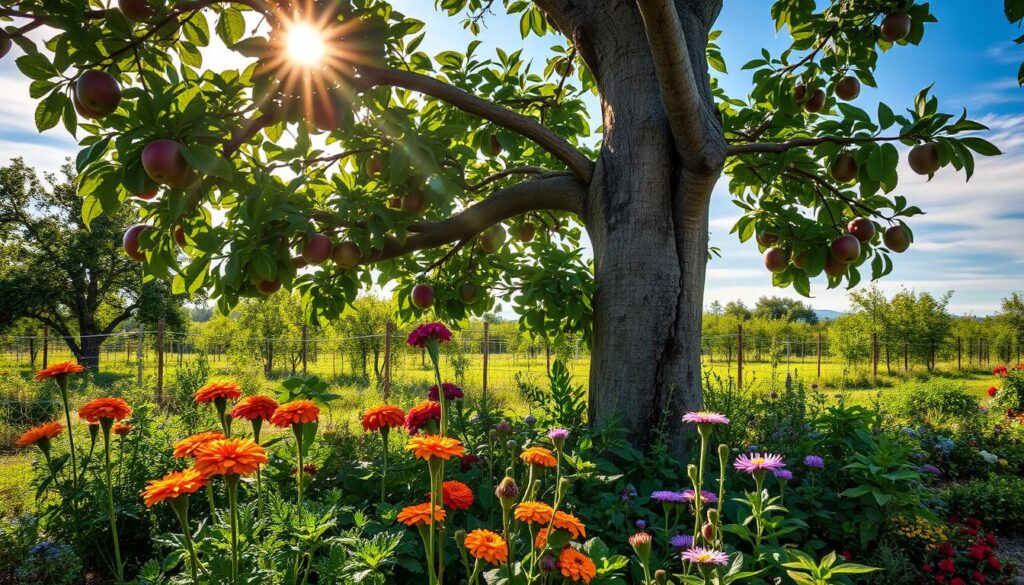
Enjoying the Fruits of Your Labor
As you stand back and admire your garden, the success of your apple tree companion plants becomes apparent not just in their growth but in their culinary potential. Companion herbs like basil, mint, and chives can bring new life to your dishes. Incorporating these culinary herbs into your cooking delights the palate while enriching the meals with fresh flavors and added nutrition.
Culinary Uses for Your Companion Plants
Transforming your harvest into delicious meals is a rewarding experience. The abundance of herbs from your garden allows for creativity in the kitchen. Fresh mint can elevate drinks or desserts, while basil enhances the taste of sauces and salads. Chives can be chopped to add a mild onion flavor to various dishes, providing versatility in your cooking.
Creating Recipes with Your Harvested Produce
Utilizing the produce from your apple tree and its companion plants can result in unique and tasty recipes. Consider making a refreshing apple and herb salad, tossing sliced apples with fresh basil and a light vinaigrette. Alternatively, a mint-infused apple compote can be a delightful addition to desserts or breakfast dishes. Playing with the combination of your harvested apples and culinary herbs offers endless possibilities to explore.
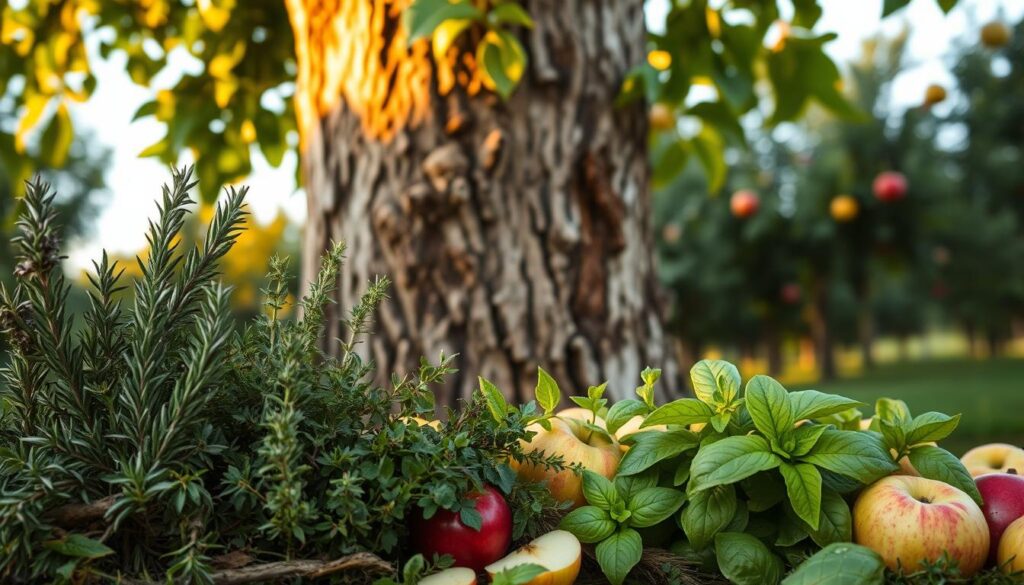
Conclusion: The Future of Your Apple Orchard
Your apple orchard has the potential to thrive even more through the practices of companion planting. By embracing apple tree biodiversity planting, you not only diversify your garden but also bolster the ecosystem that surrounds your trees. This method infuses nutrients into the soil, enhances biodiversity, and reduces the need for chemical interventions, leading to a healthier and more sustainable orchard.
Moreover, as you implement these practices, you foster a vibrant environment that encourages beneficial insects and deters pests naturally. This balance becomes an essential part of your apple tree polyculture, promoting healthy growth and optimum yields all season long. With compatibility in mind, you are building a resilient garden that thrives on collaboration rather than competition among plants.
Looking ahead, the benefits of companion planting can usher in a bountiful harvest, allowing you to enjoy the fruits of your labor with ease. As you continue to adapt and nurture these sustainable practices, you lay the groundwork for a flourishing apple orchard that not only looks great but also aligns with nature’s rhythm. Embrace this journey as you witness your trees and companion plants working harmoniously together, proving that sustainable gardening is possible and rewarding.
